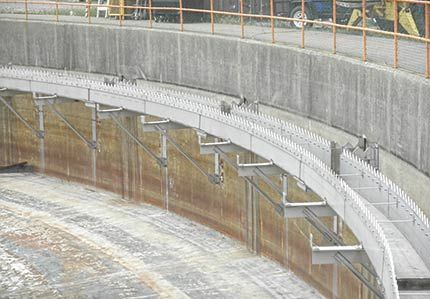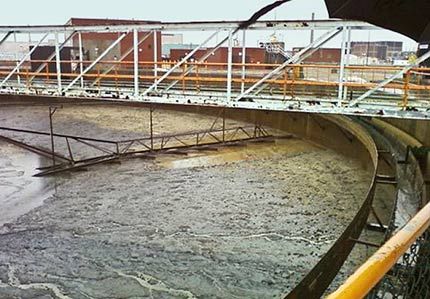Replacement of Four Primary Clarifiers Saves City of Detroit Millions of Dollars (Case Study)
Published on by Water Network Research, Official research team of The Water Network in Case Studies
This case study shows how replacement of four 250 ft. diameter primary clarifiers saved City of Detroit millions of dollars on wastewater treatment plant upgrades.

After: New weirs, baffles, and launders (image source: monroe )
Challenge
The City of Detroit WWTP needed to upgrade (4) of its 250 ft. primary clarifiers. The plant decided to replace the internal components with a combination of mild, coated steel and non-corrosive stainless steel members. The project included converting the sludge rakes to higher efficiency spiral scrapers and rehabilitating existing drive units, as well as replacing influent wells, column supports, weirs, baffles, and launders.
Solution
Due to the size of the clarifiers and the amount of steel involved, the budget estimate for the clarifier components and accompanying work was roughly $9,000,000.
Monroe Environmental met with plant personnel and consulting engineers to discuss the project. After reviewing design and fabrication options with Monroe, including the benefits of “The Monroe Method” and being a local Michigan manufacturer, the consulting engineer issued a project addendum specifying Monroe Environmental for the clarifier equipment.
Result
Monroe was the successful low-bidder and was awarded the project. The city saved several millions of dollars on the total price of the clarifier equipment, with Monroe’s contract totaling approximately $5,000,000. Engineering submittals including new spiral scraper rake designs, structural analysis, and related drawings were approved in the 3rd quarter of 2011 and fabrication of the equipment began shortly thereafter. The project was completed in 2014.

Before: Upgrade of four 250 ft. Primary Clarifiers. The project included converting the sludge rakes to higher efficiency spiral scrapers and rehabilitating existing drive units, as well as replacing influent wells, column supports, weirs, baffles, and launders with a combination of mild, coated steel and non–corrosive stainless steel members. (image source: monroe )
Source: Monroe Environmental
Media
Taxonomy
- Treatment
- Sludge Separation
- Sludge Treatment
- Sludge Management
- Sludge Drying
- Treatment Plants
- Wastewater Treatment Plant Design
- Slurry Pumping
- Clarifier